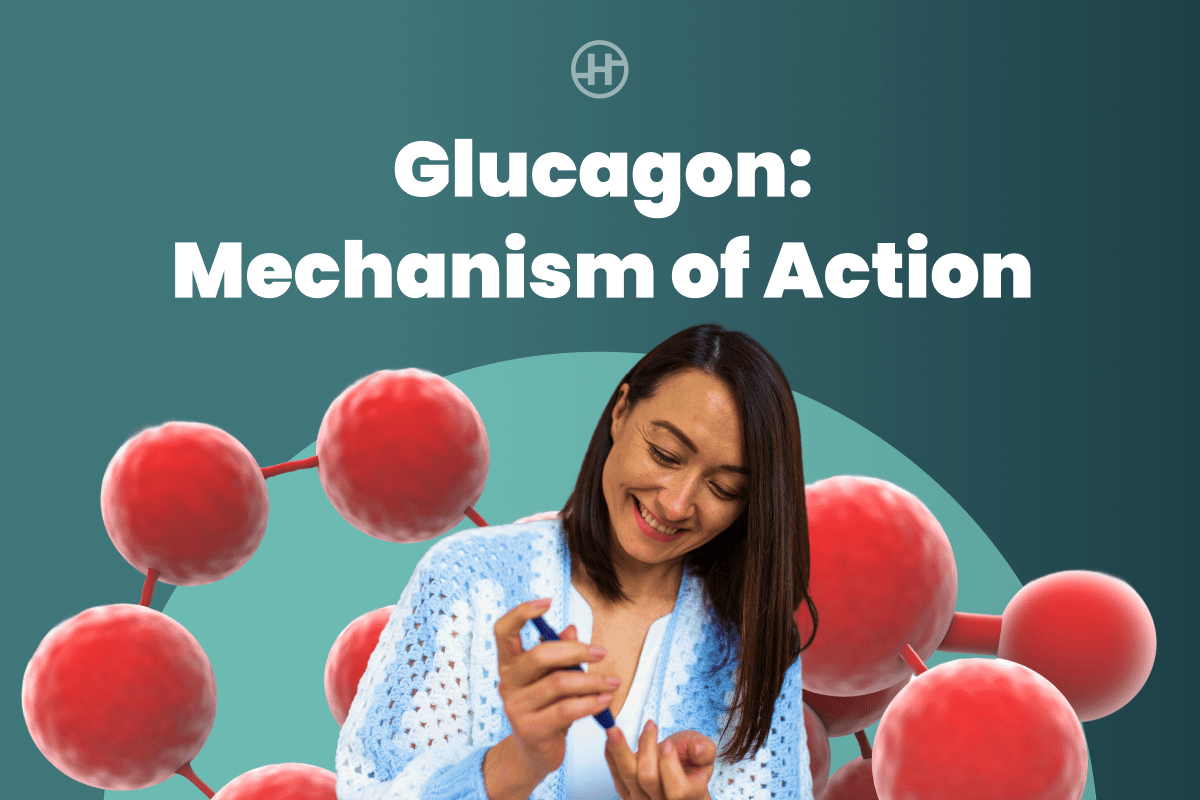Glucagon Mechanism Of Action: Key To Blood Sugar Control

In recent years, there has been a growing wave of curiosity around glucagon, the lesser-known counterpart to insulin. While insulin often gets the spotlight in conversations about blood sugar, glucagon quietly does the work behind the scenes to ensure your body has enough glucose during fasting, exercise, or low sugar levels. This balance between insulin and glucagon is vital to keeping your metabolism running smoothly.
Researchers have long studied glucagon as a hormone that increases blood sugar levels. But modern research has brought it back into the spotlight for more reasons. It is now recognized not just as a key player in glucose regulation but also as a target for treating type 2 diabetes. The glucagon mechanism of action (how it works at the cellular and hormonal level) is more important today than ever before. And it goes far beyond blood sugar.
Yet despite its medical significance, people still have basic questions. Is glucagon a peptide hormone? What is the structure of glucagon? What exactly does it do? And how does it differ from insulin? This article answers all of these questions and offers a detailed, easy-to-understand overview of the glucagon mechanism of action, so you walk away with the clarity you deserve.
What is Glucagon?
Glucagon is a natural hormone made by the alpha cells in your pancreas, specifically within the islets of Langerhans. It is a critical hormone that works to raise blood sugar levels when they fall too low. It does so by signaling the liver to release stored glucose back into the bloodstream. You can think of glucagon as your body’s safety net during periods of fasting or energy demand.
The pancreas constantly monitors blood glucose levels. When levels drop too low (during sleep, intense exercise, or long periods without eating), glucagon kicks in to restore balance. This hormonal response is essential because glucose is the body’s primary fuel, especially for the brain and nervous system. Without sufficient glucose, cognitive and physical functions can be compromised.
The importance of glucagon is especially seen in people with diabetes, who may experience impaired or exaggerated glucagon responses. Understanding this hormone is a step toward understanding how to better manage energy, sugar levels, and long-term metabolic health.
Glucagon Structure
Yes, glucagon is a peptide hormone. That means it is composed of a chain of amino acids. Specifically, glucagon is made up of 29 amino acids and is derived from a larger precursor molecule called proglucagon. This precursor is processed differently in different parts of the body.
In the pancreas, prohormone convertase 2 (PC2) acts on proglucagon to produce glucagon. However, in other organs like the intestines or brain, a different enzyme (prohormone convertase 1/3 (PC1/3)) converts proglucagon into GLP-1 (glucagon-like peptide 1) and GLP-2. These hormones have different effects but are chemically related to glucagon.
The glucagon structure allows it to bind to its specific receptor (the glucagon receptor), which is located mostly on liver cells. This receptor is a G protein-coupled receptor (GPCR), which activates a cascade of signals that result in glucose being released into the bloodstream.
The glucagon mechanism of action begins when blood glucose levels fall. The pancreas senses the drop. Then, it releases glucagon into the bloodstream. From there, glucagon travels to the liver and binds to the glucagon receptor, initiating a series of cellular events.
Let us break down the major processes triggered by glucagon:
1. Activating the Liver to Release Glucose
Once blood sugar levels start falling, glucagon is secreted by pancreatic alpha cells and travels to the liver. There, it binds to specific receptors that trigger an internal signaling pathway, causing the liver to start producing and releasing glucose into the bloodstream. This process helps the body maintain energy, especially for organs like the brain that rely on a steady glucose supply.
2. Breaking Down Glycogen (Glycogenolysis)
The liver stores glucose in a form called glycogen, which is like a sugar reserve. When glucagon levels rise, the liver breaks down glycogen into glucose and releases it into the blood. This process provides a rapid supply of energy between meals or during intense physical activity.
3. Creating New Glucose (Gluconeogenesis)
If glycogen stores are running low, especially during prolonged fasting, glucagon helps the liver make glucose from other sources, such as amino acids from protein. It is crucial for maintaining blood sugar levels when carbohydrates are unavailable.
4. Shifting Away from Fat Storage (Anti-Lipogenesis)
Glucagon causes the liver to stop turning glucose into fat. Instead of storing extra energy, the body begins to use it. It helps prevent unnecessary fat buildup and ensures the liver focuses on keeping blood sugar stable.
5. Producing Ketones and Using Fat for Energy
When fasting or on a low-carb diet, glucagon signals the liver to break down fat into ketones, an alternative fuel for the brain and muscles. This process, known as ketogenesis, helps the body adapt to energy shortages by shifting to fat-burning mode.
These five actions work together to ensure that your body always has access to the energy it needs, even when food intake is low or physical activity is high. That is why glucagon action is considered essential to survival during fasting, illness, or hypoglycemia.
Why is Glucagon Important for Blood Sugar Balance?
The interplay between glucagon and insulin keeps blood sugar within a healthy range. While insulin stores sugar, glucagon releases it. In people without diabetes, these two hormones function like thermostats, adjusting based on whether sugar levels are rising or falling.
However, in diabetes (especially type 2), this balance is disrupted. People may have too much glucagon (hyperglucagonemia), even when blood sugar is already high. It worsens hyperglycemia and complicates treatment. In type 1 diabetes, the glucagon response to hypoglycemia may be absent. That makes it hard for the body to recover from insulin-induced low sugar episodes.
That is why many new therapies (including GLP-1 receptor agonists) work in part by suppressing glucagon after meals. It helps limit post-meal sugar spikes and supports better glucose control.
Glucagon in Diabetes and Metabolic Disorders
In people with type 2 diabetes, the regulation of glucagon becomes disrupted. Instead of decreasing after a meal, glucagon levels may remain high. Hence, it contributes to elevated blood sugar. This phenomenon is now recognized as a major contributor to the disease. In fact, the “bihormonal hypothesis” suggests that hyperglucagonemia, in addition to hypoinsulinemia, is central to diabetic hyperglycemia.
In type 1 diabetes, the body loses its ability to produce insulin and sometimes loses proper glucagon signaling. That makes the person more vulnerable to hypoglycemia, especially during insulin therapy. These insights have led to newer treatment approaches that target not just insulin but also glucagon pathways.
Interestingly, glucagon is also being explored as a target for treating obesity and non-alcoholic fatty liver disease (NAFLD). Impaired amino acid metabolism, abnormal glucagon levels, and liver fat content are all interconnected in what is now described as the liver-alpha cell axis, which is a feedback loop between the liver and glucagon-producing alpha cells.
Role of Glucagon Beyond Blood Sugar
Newer research has shown that the glucagon hormone function goes beyond just managing blood sugar. It plays significant roles in broader aspects of energy metabolism:
- Stimulates fat breakdown: Glucagon promotes the breakdown of fatty acids in the liver, a process that provides energy when food intake is limited.
- Supports ketone production: During prolonged fasting or low-carb intake, glucagon helps generate ketone bodies that serve as alternative energy sources.
- Affects appetite: High doses of glucagon have been shown to reduce food intake, suggesting a role in appetite control, although this effect may be indirect.
- Increases energy expenditure: Glucagon may raise resting energy expenditure in humans, although the mechanism is still under study.
- Supports amino acid breakdown: Glucagon assists in converting amino acids into glucose and in eliminating excess nitrogen via urea formation.
All these make glucagon an essential hormone for glucose regulation and maintaining metabolic balance in the body.
Conditions Related to Glucagon Dysfunction
Disruption in glucagon production or response is often linked to diabetes, but it can also occur in several other conditions. Here are some important disorders, explained with their connection to glucagon:
1. Glucagonoma
It is a rare pancreatic tumor that causes excessive glucagon production. High glucagon levels lead to persistent high blood sugar (hyperglycemia), severe weight loss, and a distinct rash known as necrolytic migratory erythema. It reflects what happens when glucagon goes unchecked in the body.
2. Pancreatitis
In cases of chronic or severe pancreatitis, the pancreas may lose its ability to function properly. It includes the loss of both insulin- and glucagon-producing cells. As a result, blood sugar levels become difficult to manage, and the risk of hypoglycemia increases when insulin therapy is used without an appropriate glucagon response.
3. Multiple Endocrine Neoplasia (MEN)
MEN is a genetic condition that causes tumors in multiple hormone-producing glands, including the pancreas. When glucagon-producing alpha cells are involved, abnormal secretion of glucagon can result. It contributes to glucose imbalance and other systemic symptoms.
4. Pancreatectomy (Surgical Removal of the Pancreas)
When the pancreas is partially or entirely removed due to injury, cancer, or chronic pancreatitis, both insulin and glucagon production are affected. That leads to a dual deficiency: the risk of both hyperglycemia and severe hypoglycemia increases, depending on the therapy used.
These conditions show how critical glucagon hormone function is, not just in regulating blood sugar, but also in maintaining broader metabolic balance. Any dysfunction can lead to serious and complex medical challenges.
Symptoms Linked to Abnormal Glucagon Activity
Whether too little or too much, abnormal glucagon activity can lead to noticeable symptoms:
Low glucagon response (hypoglycemia risk)
- Shaking, sweating, and dizziness
- Rapid heartbeat
- Confusion or trouble concentrating
- Hunger and weakness
High glucagon levels (hyperglycemia or tumor-related)
- Frequent urination and thirst
- Blurred vision
- Unexplained weight loss
- Red, itchy skin rash (in glucagonoma)
Testing and Monitoring Glucagon Levels
You may order a glucagon blood test to assess suspected issues, though it is not a routine test in diabetes care. Blood is drawn and tested in a lab. Normal glucagon levels generally range between 50 and 100 picograms per milliliter (pg/mL), though reference ranges can vary.
Factors like fasting duration, protein intake, and time of testing can influence glucagon levels. Discuss your lab results with your doctor to interpret them correctly.
Glucagon Regulation and the Role of GLP-1
To understand the future of diabetes and weight management, it is important to see how GLP-1 (glucagon-like peptide-1) interacts with glucagon regulation. GLP-1 is a hormone secreted in the gut shortly after eating. It plays a dual role: stimulating insulin release and suppressing glucagon secretion, especially when blood sugar is high. This coordinated response is critical for blood glucose regulation and offers valuable insight into why GLP-1-based medications are gaining global popularity.
Here is how GLP-1 connects with glucagon regulation:
- Inhibits Glucagon at High Glucose Levels: GLP-1 suppresses glucagon secretion from alpha cells when blood sugar levels are already elevated. This helps prevent excess glucose production from the liver.
- Stimulates Insulin: At the same time, GLP-1 promotes insulin release from pancreatic beta cells. This dual action (suppressing glucagon and stimulating insulin) enhances the body’s ability to regulate glucose efficiently.
- Therapeutic Value: GLP-1 receptor agonists, such as semaglutide and liraglutide, mimic the action of natural GLP-1. They are used to treat type 2 diabetes and obesity because they help control both insulin and glucagon levels.
- Supports Weight Management: Beyond blood sugar, GLP-1’s ability to slow gastric emptying and reduce appetite has made it a target for weight loss therapies.
- Reduces Hypoglycemia Risk: Unlike insulin, GLP-1 primarily works when glucose levels are high, making it a safer choice for avoiding hypoglycemia.
The GLP-1 + Healthify Coach plan is based on these scientific principles. It leverages the power of GLP-1 medications while combining them with expert diet, fitness, and medical support. Ultimately, it aims to ensure that the effects are safe, sustainable, and personalized.
HealthifyMe Note
It is easy to focus solely on insulin when discussing blood sugar, but glucagon deserves equal attention. This hormone works tirelessly behind the scenes, helping the body tap into energy reserves when needed. Understanding its role offers deeper insight into managing diabetes, weight, and overall metabolic health. At HealthifyMe, we believe that knowing how your hormones function is a step toward choosing the right strategies. Whether it is GLP-1 medication, dietary adjustments, or fitness routines, actual change begins with awareness. Let your body’s signals guide your goals, backed by expert advice.
The Final Word
The glucagon mechanism of action is more than just a biological process; it is a life-saving response to energy needs. From regulating blood sugar between meals to supporting fasting metabolism and protecting brain function during hypoglycemia, glucagon does a lot more than people realize. It is the body’s built-in defense mechanism when glucose levels fall.
As science advances, we are learning that glucagon is relevant not just to diabetes but also to energy expenditure, liver function, and amino acid regulation. It is being studied not only as a hormone to control but also as a therapeutic target. This opens new possibilities for managing metabolic conditions more holistically.
For those considering medical interventions, combining therapy with professional coaching makes a huge difference. GLP-1 + Healthify Coach is one such offering that blends medication with human insight. After all, medication can support the journey, but behavior, awareness, and guidance ensure lasting results. Let your care be complete, not just chemical.
Frequently Asked Questions (FAQs)
Q: What is the main function of glucagon in the body?
A: Glucagon’s primary role is to raise blood sugar levels when they fall too low. It signals the liver to break down stored glycogen into glucose and release it into the bloodstream, ensuring your brain and body have enough energy during fasting or exercise.
Q: Is glucagon a peptide hormone?
A: Yes, glucagon is a 29-amino acid peptide hormone produced by the pancreas. It is classified as such because it is made of a short chain of amino acids and acts on specific receptors to trigger metabolic processes.
Q: What is the structure of glucagon?
A: Glucagon has a linear structure of 29 amino acids and is derived from a larger protein called proglucagon. It is processed by enzymes into its active form and works by binding to specific glucagon receptors in liver cells.
Q: How does glucagon differ from insulin?
A: While insulin lowers blood sugar by helping cells absorb glucose, glucagon raises blood sugar by telling the liver to release stored glucose. Together, they work like a thermostat to maintain stable glucose levels in the body.
Q: When is glucagon used medically?
A: Glucagon is used in emergency medicine, particularly for treating severe hypoglycemia in people with diabetes. It is available as injections or nasal sprays and quickly raises blood sugar levels by mobilizing liver glucose.
Q: What are the symptoms of high or low glucagon levels?
A: Low glucagon can lead to hypoglycemia, which can cause shakiness, dizziness, and confusion. High glucagon may cause elevated blood sugar, thirst, and fatigue and, in rare cases, may indicate a tumor called glucagonoma.
Q: Can glucagon levels be controlled with medication or lifestyle?
A: Yes, some medications like GLP-1 agonists help regulate glucagon. Lifestyle factors like balanced meals, exercise, and managing stress can also support better hormonal balance. Expert-led programs like GLP-1 + Healthify Coach offer integrated strategies to keep glucagon and other hormones in check.
Research Sources
1. Glucagon Physiology – National Library of Medicine
3. Endocrine Society. Pancreas Hormones
4. National Cancer Institute (U.S.). Definition of Gluconeogenesis5. National Library of Medicine (U.S.). Glucagon Blood Test




